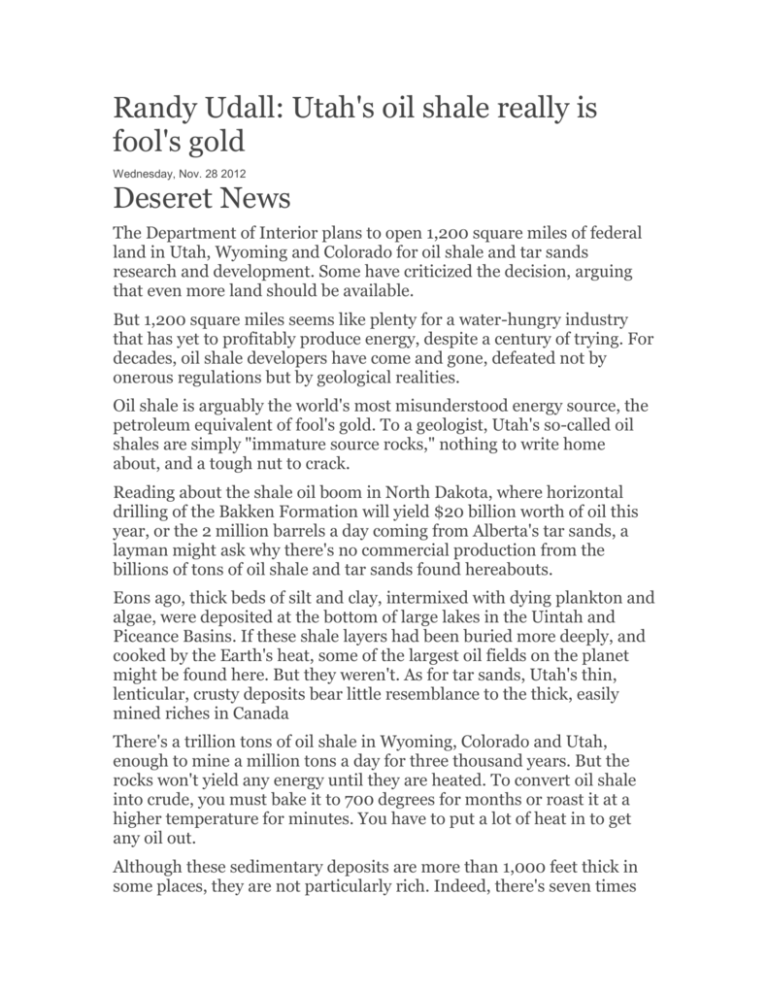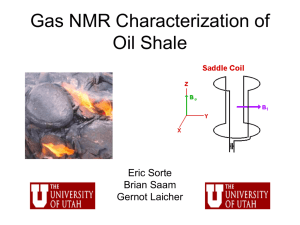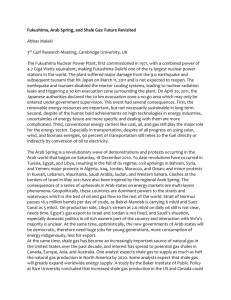Randy Udall: Utah`s oil shale really is fool`s gold
advertisement

Randy Udall: Utah's oil shale really is fool's gold Wednesday, Nov. 28 2012 Deseret News The Department of Interior plans to open 1,200 square miles of federal land in Utah, Wyoming and Colorado for oil shale and tar sands research and development. Some have criticized the decision, arguing that even more land should be available. But 1,200 square miles seems like plenty for a water-hungry industry that has yet to profitably produce energy, despite a century of trying. For decades, oil shale developers have come and gone, defeated not by onerous regulations but by geological realities. Oil shale is arguably the world's most misunderstood energy source, the petroleum equivalent of fool's gold. To a geologist, Utah's so-called oil shales are simply "immature source rocks," nothing to write home about, and a tough nut to crack. Reading about the shale oil boom in North Dakota, where horizontal drilling of the Bakken Formation will yield $20 billion worth of oil this year, or the 2 million barrels a day coming from Alberta's tar sands, a layman might ask why there's no commercial production from the billions of tons of oil shale and tar sands found hereabouts. Eons ago, thick beds of silt and clay, intermixed with dying plankton and algae, were deposited at the bottom of large lakes in the Uintah and Piceance Basins. If these shale layers had been buried more deeply, and cooked by the Earth's heat, some of the largest oil fields on the planet might be found here. But they weren't. As for tar sands, Utah's thin, lenticular, crusty deposits bear little resemblance to the thick, easily mined riches in Canada There's a trillion tons of oil shale in Wyoming, Colorado and Utah, enough to mine a million tons a day for three thousand years. But the rocks won't yield any energy until they are heated. To convert oil shale into crude, you must bake it to 700 degrees for months or roast it at a higher temperature for minutes. You have to put a lot of heat in to get any oil out. Although these sedimentary deposits are more than 1,000 feet thick in some places, they are not particularly rich. Indeed, there's seven times more energy in a ton of coal than in a ton of oil shale, which is why Mormon pioneers preferred to use wood or coal or even buffalo chips. To produce oil shale the rocks must be mined, crushed, hauled and processed. But 90 percent of the tonnage you roast is inert, valueless. The challenges of putting oil shale to work can be illustrated with a redneck thought experiment. Oil shale is abundant near Vernal, and in theory you could cheaply heat your house with it. But during a cold snap, you'd have to heat 400 pounds of rocks each day, while disposing of 300 pounds of gritty ash. Come spring, your yard would be a Superfund site. Natural gas burns cleaner and makes much more environmental sense, which is why the Uintah Basin is a hotbed for drilling. And don't forget that oil shale is a thirsty enterprise, too. One estimate from the Government Accountability Office said that large-scale oil shale development could require as much water as 750,000 households. Nonetheless, as oil prices have risen to $100 a barrel, some companies are taking a fresh look. Shell has spent an estimated $1 billion in the last 15 years trying to unlock these stubborn rocks in western Colorado. Exxon has recently secured some federal land for its research. Both corporations say first production is at least 10 years away. An Estonian company called Enefit is the world's leader in oil shale technology, and it has announced plans to build enormous retorts, or ovens, in eastern Utah. But each of these facilities may cost up to $1 billion and will take years to construct. This suggests that the first production of oil shale in Utah may come from Red Leaf Resources, which has secured financing from the French oil giant, Total. Small volumes of oil shale are produced in Brazil, China and Estonia, and it's not out of the question that Red Leaf or Enefit or Exxon or Shell will succeed in their ventures. We should wish them well, while protecting our air and water. At the same time, history teaches that oil shale is neither a magic bullet nor a quick path to energy independence. Those who parrot the old saw about there being "three times more oil in Utah and Colorado than in Saudi Arabia" are ill-informed. Yes, we Americans love panaceas. We want a pill to cure baldness, slimmer thighs in 30 days, a magic gadget to double our engine's fuel economy. And yes, federal and state governments have an interest in seeing whether it's possible to produce oil shale economically. But the hard truth is that drillers in North Dakota will produce more oil in the next 12 months than the oil shale industry has in 120 years. Randy Udall is an energy analyst who lives in western Colorado.







